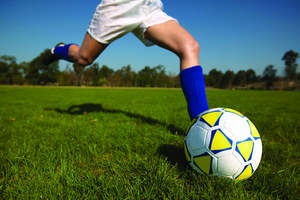MISSION, KS--(Marketwire - Apr 25, 2011) - (Family Features) When it's time to get the kids ready for sports practice or the big game, there's one piece of equipment that should always be included -- protective eyewear. Sports-related eye injuries are more common than you might think, and kids are particularly vulnerable.
Balls, bats, racquets and contact with other players can cause temporary injuries as well as long-term vision problems -- even cataracts and blindness.
Almost three-quarters (72 percent) of sports-related eye injuries happen to those younger than 25, while approximately 43 percent occur in children younger than 15, according to the U.S. Consumer Product Safety Commission. But the American Academy of Ophthalmology says that 90 percent of serious eye injuries are preventable through use of appropriate protective eyewear.
What You Need to Know
Regular eyeglasses and sunglasses are not enough. They aren't strong enough to stand up to hard blows or fast-flying objects. Ameritas Group, a leading provider of dental, eye care and hearing care plans, offers these tips for choosing the right protective eyewear and protecting your child's vision:
- If your child wears prescription eyeglasses, ask your eye doctor to fit your child with prescription eye guards.
- Eye guards with polycarbonate lenses are the most impact resistant, so be sure you know what you're buying.
- Choose protective eyewear with wraparound frames to help protect the eyes from all sides.
- Make sure protective eyewear fits properly. Most come with an adjustable strap to accommodate growth. If frames are too large, they won't provide enough protection and could obstruct peripheral vision. If they are too small, they can be uncomfortable and make it too tempting to leave them off.
- Some eye guards come with an anti-fog coating, or side vents to prevent fogging. Try on different types to figure out which will work best for your child.
- Kids grow quickly, so check the fit of your child's protective eyewear at least once a year, more often if he or she has had a growth spurt.
Each sport has specific requirements for eye protection. Check the packaging to make sure the product you select has been tested for use in your child's sport. These requirements are established and certified by each sport's governing body and/or the American Society for Testing and Materials (ASTM).
The eye-safety standards by sport are:
- ASTM F803: Eye protectors for selected sports (racket sports, women's lacrosse, field hockey, baseball, basketball)
- ASTM F513: Eye and face protective equipment for hockey players
- ASTM F1776: Eye protectors for use by players of paintball sports
- ASTM F1587: Head and face protective equipment for ice hockey goaltenders
- ASTM F910: Face guards for youth baseball
For more about vision protection, visit www.ameritasgroup.com.
Contact Information:
Wendy MacDonald
wmacdonald@familyfeatures.com
1-888-824-3337 ext. 235
http://editors.familyfeatures.com
